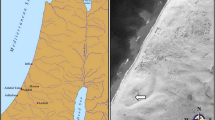Abstract
The Fu Hao Tomb is one of the most representative Shang dynasty (1600–1046 BC) royal tombs, and the handle-shaped artefact unearthed from this tomb is a special jade object manufactured during the Three Dynasties Period (the Xia, Shang, and Zhou dynasties, c. 2000–200 BC). For a long time, the manufacturing technology and the function of handle-shaped object remain an unsolved problem in academic research. In this article, one piece of the typical handle-shaped artefact from the Fu Hao Tomb (c. 1250–1192 BC) is analysed by utilising Raman spectrometer and scanning electron microscope and observed by a microscope to investigate the carving technology and the purpose of their usage. The results suggest that the carving technologies applied on the handle-shaped artefact are different among various sections of its body: the bottom part is rougher than the other parts, which indicate the bottom is connected to other objects by mortise and tenon joints. This type of artefact should be considered as the origin of a new form of handle-shaped artefacts manufactured during the Western Zhou Dynasty (1122–771 BC). Combined with previous work, the authors suggest the handle-shaped artefacts were used as a form of sacrificial offering during celebrations and funerals in ancient times.





Similar content being viewed by others
References
Cao N (2008) A study of the handle-shaped jades from the Three Dynasties Period (in Chinese). Acta Archaeol Sin 2:141–174
Cui DL (2001) Appreciation of Chinese jade culture (in Chinese), vol 193. China Drama Press, Beijing
Dong JQ, Gan FX, Cheng HS, Hu YQ, Cheng YJ, Chai ZQ, Zhou JS, Gu DH, Zhao HX (2011) The Study of the Three Dynasties jades from Henan Province, China. Huaxia Archaeol 3:30–50
Gan FX (2008) Several points of view on scientific archeological research of Chines ancient jade artifacts and jades (in Chinese). Sci Conserv Archaeol 20:17–26
Gao XP (2010) A study on damaged vessels and spirit vessels in Shang burials (in Chinese). Archaeol Cultur Relics 1:42–49
Gu Z, Pan WB, Song GD, Qiu ZW, Yang YM, Wang CS (2014) Investigating the tool marks of stone reliefs from the Mausoleum of Cao Cao (AD155-AD220) in China. J Archaeol Sci 43:31–37
Guo BJ (1951) The excavation report of Yinxu in Spring, 1950 (in Chinese). Acta Archaeol Sin 5:1–61
Guo DS (2005) Hongshan Archaeological Culture (in Chinese). Cultural Relics Press, Beijing
Li XY (2008) Study on jade handle-shaped artefact (in Chinese). Jilin University, Changchun
Li XY, Jing ZW (2012) Handle-shaped artefact should be designated as Zan (in Chinese). Archaeol Cultur Relics 3:34–53
Lu LC, Hu ZS (1988) The Yu Marquis Cemetery in Baoji, China(in Chinese). Cultural Relics Press, Beijing, pp 332–334
Rinaudo C, Belluso E, Gastaldi D (2004) Assessment of the use of raman spectroscopy for the determination of amphibole asbestos. Mineral Mag 68(3):455–465
Sax M, Ji KZ (2013) The technology of jades excavated at the Western Zhou, Jin Marquis Cemetery, Tianma-Qucun, Beizhao, Shanxi Province: Recognition of Tools and Techniques. J Archaeol Sci 40:1067–1079
Sax M, Meeks ND, Michaelson C, Middleton AP (2004) The identification of carving techniques on Chinese jade. J Archaeol Sci 31:1413–1428
Shi ZR (1973) Xiaotun 1, Yinxu Tombs III (in Chinese). Institute of History and Philology of Academia Sinica, Taipei
Shi RC (2010) A study on archaeological handle-shaped jade (in Chinese). Sichuan Cult Relics 3:22–30
Song AP (2004) A study on the jade articles unearthed from the Zhengzhou Walled- city (in Chinese). Cult Relics Cent China 5:46–58
The Institute of Archaeology Chinese Academy of Social Sciences (1980) Fu Hao Tomb in Yinxu (in Chinese). Cultural Relics Press, Beijing
The Institute of Archaeology Chinese Academy of Social Sciences (2005) Jade from Yinxu (in Chinese). Science Press, Beijing viii
The Institute of Archaeology Chinese Academy of Social Sciences (2014) ERLITOU: 1999-2006 (in Chinese), vol 3. Cultural Relics Press, Beijing, p 1403
Wang YB (1988) New explanation of Ya Zhang (in Chinese). Archaeol Cultur Relics 1:36–46
Wang R, Wang CS, Tang JG (2018) A jade parrot from the tomb of. Fu Hao Yinxu Liao Sacrifices Shang Dyn 92(362):362–382
Wang R, Zhang WS (2011) Application of Raman spectroscopy in the nondestructive analyses of ancient Chinese jades. J Raman Spectrosc 42(6):1324–1329
Wei JY (2013) An opinion about jade handle-shaped artefact (in Chinese). Archaeol Cultur Relics 1:38–44
Wen G (1985) The geological and archaeological study of Chinese ancient jades (in Chinese). Scientific Papers on Geology for International Exchange, Volume 6. Geological Publishing House, Beijing, p 265
Xia N (1983) On the classification, name and function of Shang Dynasty jades (in Chinese). Archaeology 5:455–467
Yang BD (1988) The development of ancient jade in China (in Chinese). Southeast Culture 6:151
Yang JF (2009) The discussion of wheel-cutting in China ancient jade (in Chinese). Archaeol Cultur Relics 7:53–67
Ye XH, Tang JG, Xu F (2016) The cutting technology of jades from the late Shang dynasty (in Chinese). Cult Relics Southern China 04:128–140
Yue CL, Song GD, Zhu J, Ding SC, Li NS (2017) Carving technology of the handle-shaped artefacts from Yinxu (c. 1300-1046 BC) in China. Archaeometry 59(3):566–573
Zhang CS (1994) Handle-shaped artefact from the Western Zhou Dynasty (in Chinese). Archaeology 6:551–555
Zhejiang provincial institute of cultural heritage and archaeology (2003) Yao Shan (in Chinese). Cultural Relics Press, Beijing
Zheng JX (1988) Exploration on Xia Dynasty (in Chinese). Zhongzhou Ancient Books Publishing House, Zhengzhou, pp 235–236
Funding
This research was supported by Humanities and Social Sciences Research Project from the Ministry of Education of China (MOE, No. 19YJAZH130) and Digital Map of Cultural Heritage: Pilot Study of the Archaeological Sites at the Xili region, Shenzhen (Project Number: SZ2019B034).
Author information
Authors and Affiliations
Corresponding author
Additional information
Publisher’s note
Springer Nature remains neutral with regard to jurisdictional claims in published maps and institutional affiliations.
Rights and permissions
About this article
Cite this article
Yue, C., Zhu, J., Song, G. et al. An analytical research of the carving technology and the purpose of using a typical nephrite handle-shaped artefact from the Fu Hao Tomb (1250–1192 BC) in China. Archaeol Anthropol Sci 13, 56 (2021). https://doi.org/10.1007/s12520-021-01301-8
Received:
Accepted:
Published:
DOI: https://doi.org/10.1007/s12520-021-01301-8




